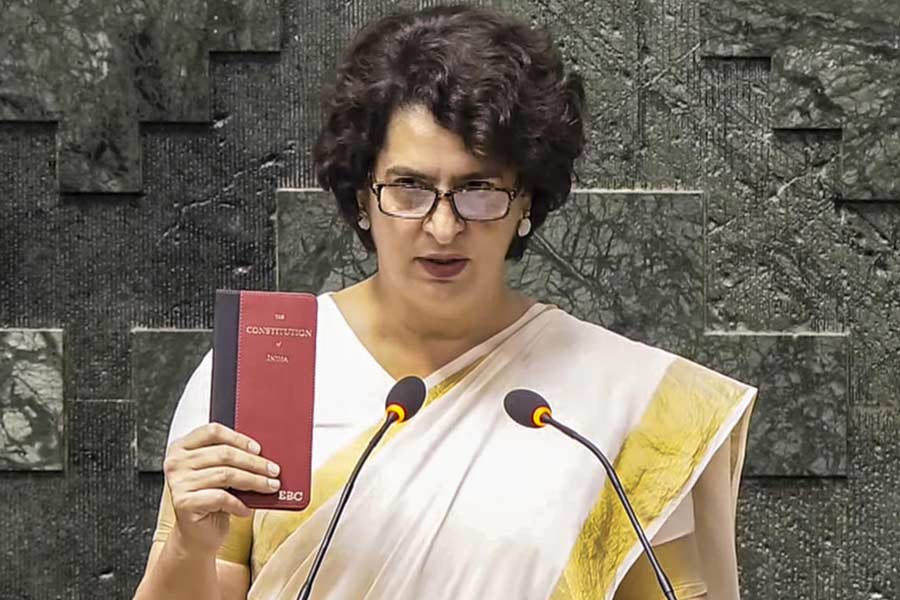 Thursday, 28 November 2024
Thursday, 28 November 2024
 Thursday, 28 November 2024
Thursday, 28 November 2024
One is a deft comedy about the misadventures of two young brides in rural India. The other is a delicate tale about the intersecting lives of three women in cosmopolitan Mumbai.
And both films might have a shot at winning Academy Awards — a rare prospect for a country that produces more than 1,000 movies a year but has found the topmost industry honors hard to come by.
With small budgets and unconventional plots, Laapataa Ladies and All We Imagine as Light have captivated audiences. That both were directed by women and have female-centric themes has become an additional point of pride in India, where the frothy romps of male-dominated Bollywood dominate the cinematic landscape.
Directed by Kiran Rao, Laapataa Ladies — renamed Lost Ladies for its Oscar campaign — has had a hugely successful run in the domestic market since its March release, and is now streaming on Netflix.
All We Imagine as Light, directed by Payal Kapadia, won the Grand Prix at Cannes in May. It was released in Indian theaters this month, and opened November 15 in New York and Los Angeles.
In a review of the movie for The New York Times, Manohla Dargis called it a “quiet drama about fragility, beauty and kinship” that is “flat-out wonderful, one of finest of the year.”
Kapadia’s victory was the first big win for an Indian film in more than three decades at Cannes. “Please don’t wait 30 years to have another Indian film,” Kapadia said while accepting the award.
Her accomplishment even won praise from India’s prime minister, Narendra Modi, who posted on the social platform X: “This prestigious accolade not only honors her exceptional skills but also inspires a new generation of Indian filmmakers.”
Kapadia’s backers hoped that her triumph at Cannes would carry her movie to even greater Oscars glory. But in September, the Film Federation of India chose to enter Laapataa Ladies as its official submission for best foreign language film at the Oscars. The decision surprised many critics, who considered All We Imagine as Light a better choice.
Representatives of Kapadia’s film called the choice a snub and are pushing for the movie to get nominations in other Oscar categories, including for best director.
“India has a long history of not electing decorated, critically acclaimed independent films,” Ezra Scott-Henning, who represents the U.S. distributor of Kapadia’s movie, said in a statement.
In explaining its choice of Laapataa Ladies, the 13-member Film Federation jury said the movie spoke to the diversity of women’s experiences in India.
The organization’s president, Ravi Kottarakara, told The Times of India that the jury “felt that All We Imagine as Light is like a foreign film and not like Indian cinema.” While quirky and smaller in scale, Laapataa Ladies fits within the general Bollywood format.
Mira Nair, the acclaimed director whose 1988 film Salaam Bombay! won the Camera d’Or prize at Cannes and was nominated for best foreign language film at the Oscars, said that “usually the committees only know, and favor, Bollywood-style storytelling.”
“The kind of films that may be favored by the Academy,” she added, “are not thought about.”
Rao, the director of Laapataa Ladies, acknowledged the pressure that her Oscar selection had placed on her and lamented the controversy over the two films.
“It is a little bit overwhelming that everyone is looking at this film to achieve something,” said Rao, speaking by phone from Los Angeles, where her team was arranging screenings for Academy Award judges. “It makes us really happy that we have so many people rooting for us, but also, we really have to keep our heads down and keep going.”
Referring to the way her film has been pitted against Kapadia’s, Rao added: “This either/or point of view needs to change, and it has to become an ‘and’ kind of conversation.”
Kapadia had a similar reaction. She said she did not see it as two female directors competing against each other, but simply as two films among the 29 that were submitted to the film federation.
The debate about whether her film would have a better shot at the Academy Awards arose because it “had gotten so much publicity during that Cannes time,” she said, and because people wanted “click bait.”
As these two movies show, Indian cinema is much more than traditional Bollywood, with its grand melodramas, romantic comedies and action thrillers dotted with song-and-dance routines. There are vibrant pockets of regional cinema around the country.
India also has a strong tradition of documentary and art house cinema. In 2021, Kapadia’s film A Night of Knowing Nothing, which chronicled a student protest movement against the Modi government, won the award for best documentary film at Cannes.
Many other films have also won awards at film festivals and played to critical acclaim globally, even if the highest honors have been elusive.
Only three movies submitted by India have been chosen as nominees for best foreign film Oscars — in 1957, 1988 and 2001. In 2023, the three-hour Telugu-language movie RRR became the first Indian feature to win an Academy Award for best original song. In 1983, Bhanu Athaiya brought India its first Oscar when she won in the costume design category for the film Gandhi.
By comparison, South Korea, with a far smaller film industry, has achieved global recognition with a breakthrough win at the Oscars. In 2020, Parasite picked up four Academy Awards, including best picture. An earlier Korean film, Oldboy, won the Grand Prix at Cannes in 2004.
“Indian cinema is really traveling far and wide,” said Anupama Chopra, a film journalist and critic. “Whether we win or not is more complex.”
Chopra said that running an awards campaign for a film was like “running a political campaign,” where money, lobbying and logistics come into play. Film critics said that international awards are just one measure of a film’s quality.
Rao and Kapadia have crisscrossed the globe recently to promote their films and generate Oscar buzz. In New York, Rao and her former husband, Bollywood megastar Aamir Khan, whose company co-produced her film, kicked off her U.S. publicity campaign at Bungalow, a popular Indian restaurant.
Kapadia, who was in Delhi this month to talk about her film before its India release, flew back to New York to attend screenings.
It can be tough to compete for attention with other international and Hollywood movies, according to the two directors.
There’s “much work to be done to amplify voices in our country, but I think we’ve made a pretty good start this year with these films,” Rao said.
Promoting a movie from India can also be challenging because the diversity of Indian cinema makes it hard to put films into neat categories that would appeal to awards committees, according to film critics and filmmakers.
“Indian cinema hasn’t been able to create a language or a vocabulary that is easily consumable in the West,” said Namrata Joshi, a film critic.
A movie made in Malayalam, a language spoken primarily in the southern Indian state of Kerala, for instance, will have a different sensibility than one made in Punjabi.
Deepti DCunha, a film programmer, has been trying to make independent Indian movies more visible by marketing them to international film festivals and educating moviemakers about funding, promotion and strategy. “Making it in the festivals circuit involves a lot of patience,” DCunha said.
Others, like Veerendra Prasad, a screenwriter and the curator of the South Asian Film Series at the University of Michigan, have sought to introduce Americans to the world of Indian cinema beyond Bollywood.
Since launching the program last year, Prasad has screened a variety of movies, from traditional Bollywood extravaganzas to independent works, with the intention of guiding people curious about Indian cinema but unsure where to start.
It’s a “gateway drug for Western cinephiles,” he said.
The New York Times Services







